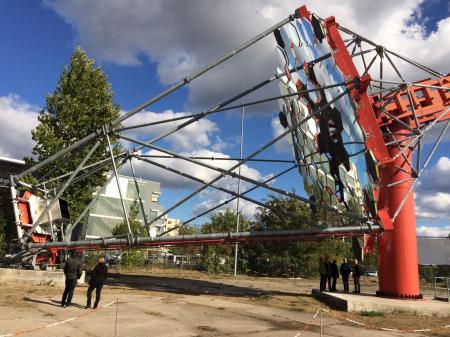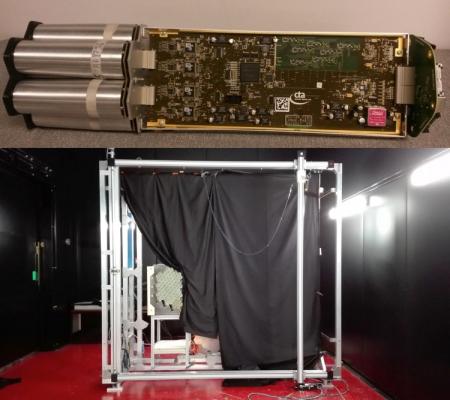
The first NectarCAM being integrated at the IRFU;left seen from the front, right seen from the rear.
NectarCAM is a camera for detecting the Cherenkov radiation of charged particles produced by very high energy photons in the Earth's atmosphere. The photons from the particle shower are imaged in the focal plane of a telescope. Telescopes equipped with this type of camera are called Cherenkov Atmospheric Imager Telescopes (IACT). By observing the same shower with the several telescopes, it is possible to reconstruct the kinematics of the incident photon (stereoscopy). The technique of observing photons with IACT is well explained at web address: https://www.mpi-hd.mpg.de/hfm/HESS/pages/about/telescopes/
The teams that built the H.E.S.S cameras are involved in the design of the NectarCAM camera which has many points in common with the telescope cameras of the H.E.S.S., MAGIC and VERITAS arrays. NectarCAM was designed for the Medium Size Telescopes (MST) telescopes of the CTA Observatory (https://cta-observatory.org). 15 MST telescopes are to be installed at the CTA North site and 25 at the South site.
The camera team :
NectarCAM cameras are created, developed, tested and installed by a consortium of about fifteen European laboratories, including about ten French CNRS / IN2P3, CNRS / INSU and CEA / Irfu research labs, four Spanish laboratories and a German laboratory. Irfu is in charge of the scientific coordination of the project, the project management, the design and the supply of the electronic components carrying out the sampling of the 1 GHz signals on 12 bits (Nectar ASICs), the integration and tests of the cameras on the site of Saclay and on the site of the CTA observatory.
The MST telescope structure is developped by a consortium led by the German DESY-Zeuthen laboratory in which Irfu participates through the design and supply of lightwigth mirrors (more).
The NectarCAM camera is to be tested on a prototype telescope structure near Berlin in early 2019.
Overview of the camera :
NectarCAM is an instrument of about 3x3x1.5 m, weighing about two tons. It has a very large field of view (8 degrees) and consists of 1855 pixels grouped into modules of 7.
up: Module grouping 7 pixels (left part) and their electronic read-out and triggering (right part). The front-end electronics can read a few tens of nanoseconds around the arrival time of Cherenkov photons in the focal plane.
IRFU is responsible for integrating the camera and verifying scientific performance. The performance verification and the calibration are done in a dark room.
down: Test chamber (dark room) at IRFU. The tested element is a set of about ten modules.
Schedule :
- When returning from Berlin in mid-2019, the integration of the remaining missing equipment will take place in Saclay, in order to finish the first complete camera or "QM".
- After integrating and testing the QM, Irfu is responsible for transport and installation on the La Palma Observatory site. This will not happen until 2020
- After 2020, a series of identical NectarCAM cameras should be fabricated, tested and delivered to the observatory. We are planning to integrate up to three cameras in parallel at the Saclay site.
Offre de stage/thèse:
Performances of a camera prototype for the very high energy gamma ray observatory CTA


